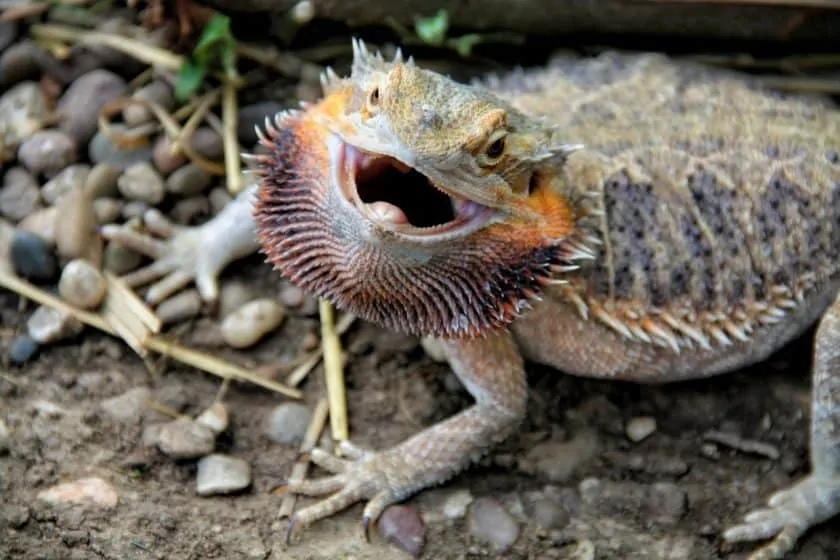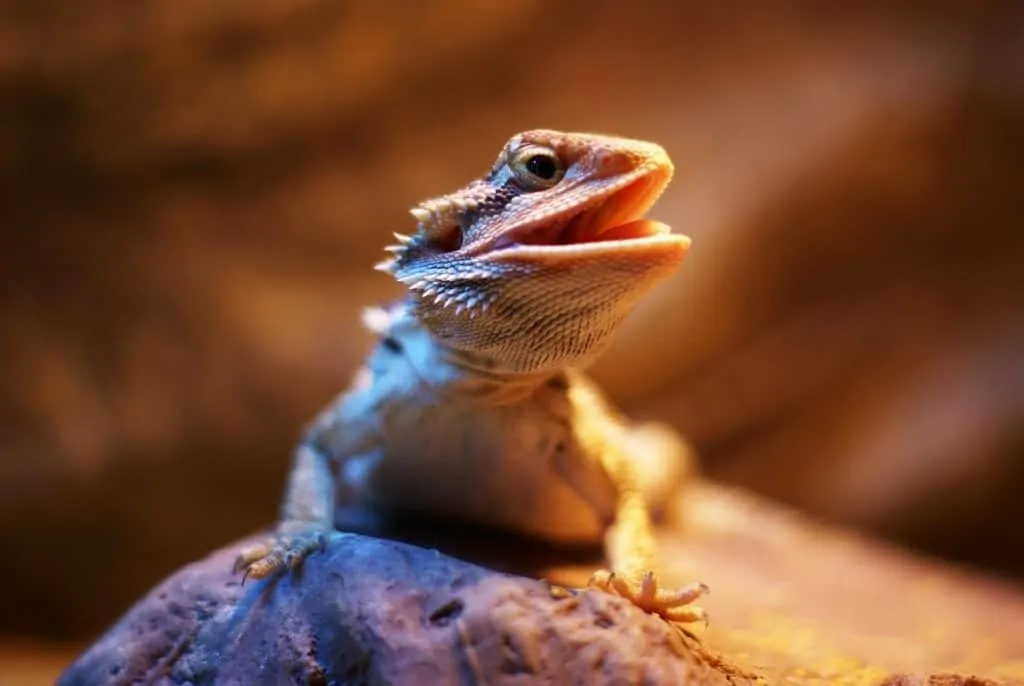You may be interested in knowing whether or not your bearded dragon is happy; however, this question is not useful for you or your pet. Trying to determine whether your pet is happy or not is anthropomorphizing.
Anthropomorphizing means attributing human thoughts and feelings to animals. You and your bearded dragon are different from each other at almost every level. You and your lizard are different in how your minds and bodies work and in how you experience the world.
A more useful question is, “How can I tell if my bearded dragon is experiencing well-being” or “Does my bearded dragon trust me?” In this article, you will learn how to determine the answers to these questions and keep your bearded dragon happy.
How Can You Tell What Mood Your Bearded Dragon Is In?
Can you tell the mood of your bearded dragon? There are a variety of ways that bearded dragons express their mood, which include coloration, body language, and aggression.
Body Language
Head bobbing is a gesture bearded dragons use to establish their hierarchal status. When bearded dragons bob their head rapidly, it is a sign of dominance. It is used to warn other lizards of lower status that they have intruded on their territory. Slow head bobbing is an indication of submission.
Coloration
The change of skin color by bearded dragons serves several purposes, including thermo regulation. By turning a dark color, bearded dragons can better soak up heat. However, bearded dragons will also turn dark as a sign of aggression or stress.
When bearded dragons turn a lighter color, it can also be for various reasons. When beardies have reached their optimal temperature, they will turn a lighter color since they do not have to work to absorb additional heat.
However, a light color can also mean that your lizard feels confident and not threatened.
Aggression
Bearded dragons show signs of aggression when they feel threatened. An aggressive posture includes hissing, puffing up their beard, and turning black. If this does not deter a threat, bearded dragons may result in biting.
If your bearded dragon does not display these signs of aggression, it may be a sign that your lizard feels comfortable with you.
How Do You Tell if a Bearded Dragon Likes You?
How can you tell if your bearded dragon likes you? Perhaps, a better question would be, how can you tell if your bearded dragon trusts you? If your bearded dragon allows you to pick it up, it indicates that it trusts you. However, this is assuming that your bearded lizard is in good health.
If your beardie flees when you reach for it or tries to get away when you are holding it, that may be a sign that it does not trust you. If these behaviors only occur occasionally, it may not be an issue. If these behaviors are the norm, that demonstrates a lack of trust.
Should your bearded dragon show a lack of trust in you, it may mean that it needs socializing. Not wanting to be held is a natural reaction for any beardie.
Your bearded dragon’s trust will be reaffirmed if it closes its eyes and rests while being handled. The natural behavior of these lizards is to stay alert to any potential threats. For your lizard to close, its eyes show a high comfort level with you.
Building Trust with Your Bearded Dragon
When reaching for your pet, avoid coming from above. For many reptiles, such movements trigger the same response from your lizard as if you were a predatory bird. Further, never make your beardie feel cornered.
The correct approach to gaining the trust of your bearded dragon is to approach them from the front, at their level. Turn your hand so it is palm upward, and gently place it under the head and upper body.
With patience and repetition, your bearded dragon will become comfortable enough for you to lift it. The most important thing to remember is that you let your lizard come to you, not the other way around.
What Do Bearded Dragons Do for Fun?
Do bearded dragons enjoy having fun? While some animals, such as dogs, appear to have fun when catching a ball, it is more difficult to determine this in reptiles. Unlike mammals, reptiles are unable to show facial expressions. If a bearded dragon plays with a toy, is it doing it for fun, or does it associate the toy with potential food?
What is safe to say is that you can provide your bearded dragon with enrichment. When your lizard gains trust in you, expose it to different environments that it can explore. Provide the conditions that will stimulate it. Examples include providing toys for your beardie or letting it run around the house.
How Do You Cheer up a Bearded Dragon?
Does your bearded dragon show happy behavior, or does it need cheering up? Does your bearded dragon appear lethargic? Is it not eating well?
Bearded dragons are normally hardy and active lizards. A healthy bearded dragon will be alert, curious, and eat regularly. Also, its eyes should be bright.
Does your bearded dragon maintains regular patterns of eating, basking, and defecating? If your bearded dragon checks all these boxes, your pet is probably enjoying good health. If your pet is not like this, it may not be getting the care it needs. The following are things to consider:
Temperature and Lighting
Your bearded dragon needs to be kept in an enclosure where the warmest part of the case is between 92-110 degrees Fahrenheit, and the cooler part is between 75-85 degrees Fahrenheit.
Also, it needs UVB lighting. Without it, it can develop Metabolic bone disease (MBD).
Illness
If your bearded dragon is not active and vital, it may have an illness. Further, most illnesses are due to improper care. Some of the more common diseases include:
- Respiratory illness
- Parasites
- Metabolic bone disease
- Impaction
- Mouth rot
Take Care!
We hope that you enjoyed this article. It is important to know how to read the signs of your pet so that you can make the needed adjustments. If your bearded dragon receives the proper care, it should enjoy well-being and trust you. We welcome your comments, and please share this article if you wish.




